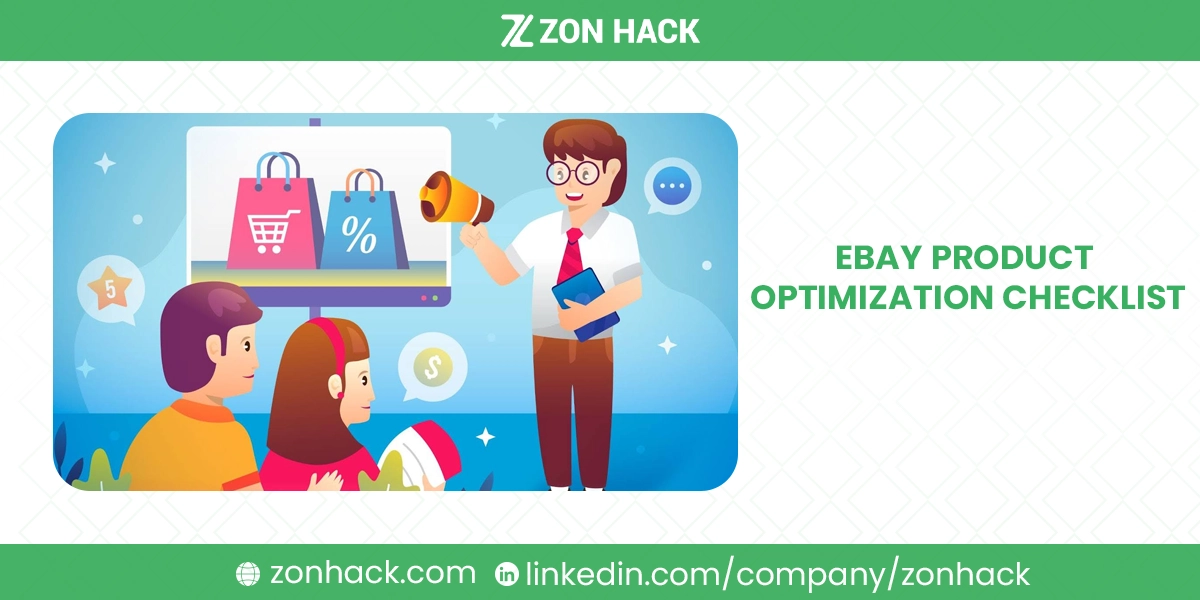I’m here to let you in on a secret. Selling on eBay isn’t just about listing an item and hoping for the best. It’s an art, a science, and a whole lot of common sense rolled into one. I’ve spent a good chunk of time figuring out what makes a listing pop versus one that just sits there, gathering digital dust. If you want more eyes on your products—and let’s be honest, who doesn’t?—you need to stop treating your listings like a quick chore and start treating them like the valuable sales tools they are.
This isn’t about being a marketing genius. It’s about being thorough. It’s about following a simple, yet powerful, eBay product optimization checklist. I’ve put together the most crucial steps you can take right now to boost your visibility, attract the right buyers, and ultimately, ring up more sales. Get ready to transform your eBay game from “meh” to “money!”
Title and Keyword Optimization
Let’s talk about the absolute most important piece of real estate on your listing: the title.
Maximize the Title: Use all 80 characters available.
Think of your title as an 80-character billboard on a busy highway. You have this small space to grab a shopper’s attention and tell them exactly what you’re selling. eBay gives you a full 80 characters for a reason. Don’t be shy about using them! A short title is a missed opportunity. Every character is a chance to include a detail that a buyer might be searching for. I try my best to fill up that space with descriptive words. It makes a huge difference in search results.
Front-Load Keywords
This is a key trick I use. The very beginning of your title is the most valuable real estate. It’s what people see first, and it’s what eBay’s search algorithm, often called Cassini, pays the most attention to. I always put the Brand Name, the Product Name, and the Model Number right up front. For example, instead of “Nice shirt, blue, size large,” I’d write “Nike Dri-FIT Men’s Large Blue Running T-Shirt.” Buyers scroll fast, and you want them to know instantly what you have.
Research Keywords
I always put myself in the buyer’s shoes. What would I type into the search bar? I don’t just stop at the name of the item. I make sure to include key details like the condition (New, Used, Open Box), color, size, material (e.g., Leather, Cotton), and any other defining features. Buyers often search using these filters. If you sell a jacket, be sure to add words like “winter,” “waterproof,” or “hooded.” These specific, long-tail keywords are gold.
Avoid Keyword Stuffing
Now, while I love using those 80 characters, I have to stress that a title must still make sense. Keyword stuffing, which is just jamming a bunch of random words together with commas, is a big no-no. It looks spammy to buyers, and it doesn’t read well. eBay’s system is smart enough to figure out related terms. My rule is simple: write the title for the buyer first, and for the search engine second. It needs to flow naturally and clearly describe the item.
Select the Correct Category
This might seem obvious, but you’d be surprised how many sellers get this wrong. Choosing the correct category is essential because buyers frequently browse or filter by category. If I’m selling a vintage toy car, I make sure it’s in “Toys & Hobbies > Diecast & Toy Vehicles” and not just “Collectibles.” A perfect title is useless if it’s hiding in the wrong section of the store. Take the extra minute to dig deep and find the most accurate home for your item.
Listing Details and Item Specifics
A killer title gets a buyer to click, but the listing details are what seals the deal. This section is where you show off your expertise and earn the buyer’s trust.
Complete Item Specifics
If I could shout one thing from the rooftops about eBay selling, it would be this: fill out every single Item Specific field! I mean it. These are the details—the Brand, Material, Style, Color, and so on—that buyers use on the left-hand side of the search results to narrow down their options. If you leave them blank, your item will simply disappear from their search. eBay is practically begging you to give them this information so they can help you sell your stuff. I make it a point to fill in every single box that’s relevant to my item.
Add Product Identifiers
For new or branded items, this is non-negotiable. Product Identifiers like the UPC (Universal Product Code), EAN (European Article Number), MPN (Manufacturer Part Number), or ISBN (International Standard Book Number) link your product to eBay’s massive product catalog. When you use them, your item is more likely to show up in external search engine results (like Google) and can even be matched with other listings for comparison. It’s a quick win for higher visibility, and I never skip it for a retail product.
Write a Detailed Description
The description is your chance to shine and handle any questions before they are even asked. I make sure my description is clear, honest, and comprehensive. I talk about everything: the item’s features, its exact condition, any flaws (be upfront about these!), measurements, and what’s included in the sale. A buyer feels much more secure purchasing from a seller who takes the time to write a thorough description. It also protects me from “Item not as described” claims later.
Use Formatting
Nobody wants to read a giant, dense wall of text. Seriously, it’s a huge turn-off. I always use bullet points for key features, measurements, and a summary of the condition. I also break up the description into short paragraphs. This simple formatting trick makes the text easy to scan and digest. A readable description is a read description, and a read description leads to a confident purchase.
Ensure Mobile Readability
Most of my buyers are shopping on their phones. I know this for a fact, and you should too. This means my description has to look great on a small screen. I avoid using tiny fonts and complex, old-school HTML templates. eBay actually recommends a font size of 16 pixels or larger. I stick to simple formatting and big, clear text. If it’s hard to read on my phone, I fix it before I launch the listing.
Images and Visuals
Images are the first thing a buyer sees, and honestly, they’re the thing that makes or breaks the click. You have to treat your photos like they are the item itself.
Use High-Quality Photos
I can’t emphasize this enough: good lighting and high resolution are non-negotiable. A blurry, dark photo screams “amateur seller” and makes the product look worse than it is. I use bright, natural light whenever possible. The ideal size that eBay loves is at least 1600 pixels on the longest side. This allows buyers to use the great zoom feature, which gives them confidence in what they are buying. Invest a few minutes in setting up a decent photo area—it pays for itself instantly.
Show Multiple Angles
Buyers want to inspect the item as if they were holding it in their hands. My goal is to let them do that digitally. I make sure to take photos of the front, back, and all sides. I also include close-ups of any important details like brand logos, special textures, or, crucially, any flaws or defects. Hiding a scratch is the fastest way to get a return. Being transparent with my photos builds trust and prevents problems.
Use a Clean Background
A cluttered background is distracting and makes your item look less professional. I always use a simple, clean background, usually white or a very light gray. This helps the product stand out and makes the colors of the item look true to life. I want the buyer’s eye to be focused only on what I’m selling, not on my messy living room.
Utilize All Photo Slots
eBay gives you up to 24 photos for free, so why not use them? I load up as many high-quality, unique images as I can. If I’m selling a pair of shoes, I’ll show the top, bottom, sides, insoles, box, and even a photo of the size tag. Every extra photo is one more piece of evidence that the item is exactly what the buyer is looking for.
Add a Product Video
This is a newer feature, but it’s a game-changer. A short video adds another layer of dynamic proof. If I’m selling an electronic device, I’ll show it turning on and functioning. If it’s clothing, I might show how the fabric drapes. It’s a fantastic way to detail the item’s condition or functionality in a way a static photo just can’t. It boosts buyer confidence and makes my listing stand out from the crowd.
Frequently Asked Questions (FAQ)
Q: Why are Item Specifics more important than my main description?
A: Think of it this way: Item Specifics are used by eBay’s search system (Cassini) to filter results. Your product will not even appear to a buyer who uses the filters if you don’t fill them out. Your main description is important for details and reassurance, but the Item Specifics are what help a buyer find you in the first place.
Q: Should I worry about using capital letters or special symbols in my title?
A: I avoid excessive capitalization (ALL CAPS) and special symbols (like $ or #). It can make the listing look aggressive or spammy. A good, clean title with normal sentence case is always the most professional and readable option.
Q: How do I know what keywords buyers are actually searching for?
A: I use a few methods. One simple one is to check the completed and sold listings for items similar to mine. See what the best-selling sellers put in their titles. Another trick is to simply start typing your product name into the eBay search bar and see what suggestions pop up. Those suggestions are based on real, frequent searches.
Conclusion
Selling on eBay isn’t just about listing an item—it’s about making it visible, appealing, and trustworthy. A strong title with the right keywords, complete details, and quality images can make all the difference. Remember, buyers can’t touch or feel your product, so your words and visuals must do the job for you.
Stay consistent with these practices, and you’ll notice higher visibility and better sales. If you’re still learning, don’t stress—it takes a bit of practice. Keep tweaking and testing until you find what works best.




